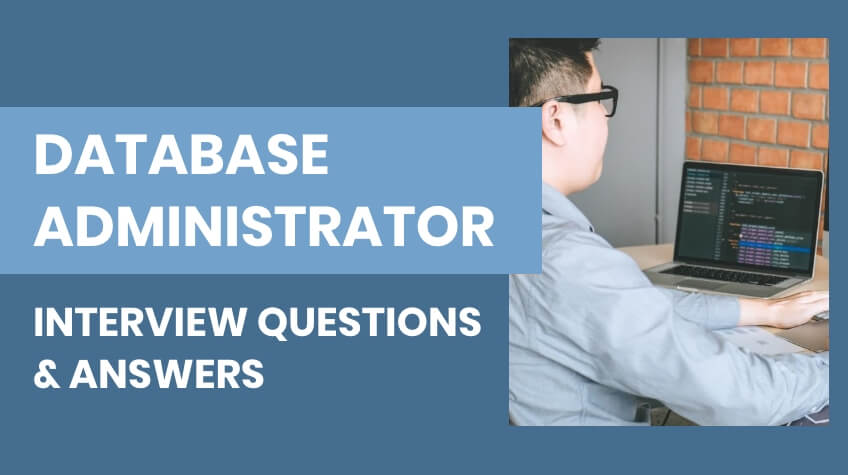
Welcome to the blog of Database Administrator interview questions. This section of the Database Administrator job description, “Important Database Administrator Interview Questions,” covers various questions you can expect in your interview with a recruiter or a hiring manager.
The questions have been categorized according to the different job roles, responsibilities, and general principles associated with all the databases. For example, the database administrator is responsible for maintaining your data’s integrity, security, and availability. In addition, you should have significant experience using SQL Server and other database management tools such as Oracle.
Database Administrator interview questions involve different types of applications and their architecture. It also relies heavily on theory and real-world experience. To be successful during this interview, it is essential that you cover the fundamentals of database design and application development.
Here are the questions asked during the interview
1. What kinds of databases do you function on?
I work with a variety of databases, but mainly with relational databases. I use them to store structured data or to organize tabular data. They are also used for supporting interactive queries, including filtering and total order reporting. Database administrators work with several databases, including SQL, Microsoft Access, Oracle, and IBM DB2.
2. Do you know about on-premises databases, cloud databases, or either?
A Database Administrator is responsible for increasing the performance and availability of databases by performing backups, building indexes, and monitoring jobs and transactions.
My background is in on-premises databases, so I am comfortable with on-premises databases, but I also have many experiences with cloud databases. This helped me get my job because the majority of the time, I could work long hours (many nights and weekends) without much trouble due to having both sorts of experience.
3. Can you explain what ODBC is?
ODBC (Open Database Connectivity) is a library of data access functions that allow applications to access data from various sources without implementing the operations themselves. ODBC is an abbreviation for Open Database Connectivity. It provides a mechanism for applications to access data, commonly stored in databases, over a network as if they were stored locally on the client’s computer.
ODBC is a Microsoft-developed interface that allows a program to access data in an SQL database. A program using ODBC can get data directly from the database using an application programming interface (API). The ODBC program is an application that allows you to access a database from a specific application. It is used by the ADO program, a programming language made specifically for working with databases.
4. What is the most elevated quantity of database servers you have worked with?
To answer this question, you must have worked with various databases. The most significant number of databases you’ve ever worked with will get you a higher score.
5. How would you manage data loss caused by a database migration?
Data loss in database migrations is not uncommon, especially when moving to a different database server. To prevent data loss during database migrations, I would ensure
1) Data is securely backed up and available in multiple locations
2) I have installed failover software to ensure that my primary database server can continue operating.
3) I have taken all necessary steps to minimize the risk of data loss.
4) If a corruption error occurs, I ensure the system is correctly restored from a backup.
Data loss caused by database migration may cause extreme disturbances to business functions. Therefore, it is essential that you transition to the new database while ensuring data integrity and security. First, the old database will be shut down and backed up using appropriate tools. Then the new database will be copied over to a different server or storage device for access. Once this process is completed and verified, the old database should only be used for the activity.
You need to ensure that the database is backed up during database migration so that the new database can be brought online at the same level of redundancy as the current one. Such an incident would require me to take some initiative and ensure that the database is backed up!
6. Do you have experience working with Hadoop?
Hadoop is a distributed storage platform. It provides computing power to run programs in parallel on many computers. What’s more, Hadoop can scale up to thousands or even tens of thousands of servers. As a result, this technology has become an essential tool for Big Data analytics and business intelligence, which have become major trends in modern companies.
7. What’s your process for troubleshooting database problems?
My process is first to try troubleshooting the issue from a command line. If that fails, I will try to work with the data, define my query for the problem, and see if that works. If it does not work or I need something specific to solve it, I will create an SQL statement and run it against my target database until I find what is causing the problem.
We work closely with our team to troubleshoot database problems. Most issues can be fixed immediately by identifying the problem, fixing it, testing to confirm everything is working correctly, and documenting the solution. I take all DB issues seriously but do my best only to fix the problem once I have all the information. When I need to know something, I need to research it and ask people who are more knowledgeable about it.
The last resort is to try and change it using a database command line interface or directly modify a database record. I do routine backups once a week and email myself a note if anything goes wrong. That way, if there’s an issue, I can check it out as quickly as possible and get things back up and running quickly. If something goes wrong and I have to contact you, my first step would be to say that I’m working on it, but the situation is unresolved.
8. Have you ever lost significant amounts of data while on the job? What was your process for handling this?
As a database administrator, I’ve lost data daily on the job. My process is to ensure that all backups are correctly stored and analyzed to determine what can be recreated and restorable through careful administration of servers. Data loss happens. We can’t always prevent it, but we can learn from it. We have had to cope with rare lost data situations. In the past, I used to tell the customer that their data was lost and that they could re-enter it or receive a refund.
However, this procedure has led to too many people filing claims against us and aggressively pursuing damages. So now we require anyone who loses data to save it on an external hard drive and contact our customer service staff for more information about repairs. We will then send them a copy of their data file so they can import any lost files back into our system. If lost data is a frequent occurrence, notify your manager.
These are situations in which the database administrator should be able to keep track of the situation and ensure that it doesn’t happen again.
9. We need to build a new database for our employee records. How would you define the system storage requirements?
We will have limited system storage requirements for this database. We need to have a column of a limited length and only two types of data in it. This is because we want our system to keep the employee records in an easy-to-read format, so they can easily be forwarded to the HR department and other departments that need access.
The system storage requirements are: The database must be able to store 3,000 employee records, each with a maximum of 500 fields. We will also need to maintain a master list of all employees that can be searched by department name, customer ID, and salary range. There will also be much reporting to do; we need information on how many hours each employee worked last month, what sales they generated during the month, and how much profit each associate made.
10. What measures would you take to safeguard our data from outer dangers?
I would measure the data retention policies as a part of my job. I would also verify that all users have strong passwords and select a user ID that is easy to remember because most people do not use good passwords like their birthday and social security numbers. The last measure I would take would be to monitor activity logs to ensure my users are not abusing permissions.
A database administrator is accountable for handling and protecting the databases within the organization. The database administrator will ensure that your company’s data is secure and protected from intrusions or unauthorized access.
The DBA will often deal with vulnerabilities that have been discovered, working with vendors and engineers to fix them and any others that spring up during the course of a project. I would install anti-virus software, patch the database whenever possible, and run regular backups. Remove all unnecessary files and disable unmovable and harmful executable files from unknown or trusted sources.
11. What are the operating modes in which Database Mirroring runs? What are the differences between them?
The operating modes of Database Mirroring are as follows: Active, Active-Standby and Active-Active. The dissimilarity among them is in how data is sent to each database. In Active-Standby mode, SQL Server can’t send data from the standby server to the primary server and vice versa. In addition, database Mirroring runs in online and offline modes.
The online mode is when data replication communication can start at any point without failover or standby. In offline mode, data replication communication needs to be initiated from the master server, whereas the other secondary database needs to be brought online before it can replicate its content to the primary database.
The operating modes are high, low, and wide availability. High availability mode means the database is mirrored on both sides of the link, so if one server crashes, the data is replicated on another. Low availability provides only a read-only duplication at each node, meaning that any change made by a user will not be replicated and must be saved to the primary drive of that account – although this could prove handy in an emergency.
Widescale allows several copies of each record to be held but with different access times to each data replica, meaning users can only access the most recent information. There are three operating modes: Active-Active, Active-Standby, and Always On. Active-Active is a mix of active and standby servers where both databases run simultaneously on the same physical server. Loads can be balanced, but the system cannot be put in maintenance mode, which would mean restoring data from backups.
The disadvantages of this deployment model are Multi-stage failover: all failures need to be addressed as a whole incident, non-disruptive recovery procedures need to be developed, no protection against single points of failure.
12. How can data be transferred from MySQL to Microsoft SQL Server?
I utilise a mix of tools, including SSIS (SQL Server Integration Services) and scripts for data transfer. First, I would examine the schema in both databases to find out any compatibility concerns. Then, I would move on to the data transfer, making sure that data integrity is preserved.
13. How often do you conduct tests to ensure data privacy?
Since data privacy is one of the major concerns, so I make sure that I conduct routine audits and tests. In my previous organization (if you are an experienced data administrator), I used to conduct audits and tests every quarter to verify the effectiveness and currency of all security measures.
14. Do you think conducting a test on a live database is advisable? What are the reasons for or against it?
Running tests on a live database is not advisable as there are potential risks involved in it. I would prefer opting for a staging environment that replicates the live database for testing.
15. Have you worked with SQL? What are the most practical SQL queries and their respective functions?
Yes, I have worked with SQL for a pretty long time. The most practical SQL queries include SELECT for data retrieval, INSERT for adding new records, UPDATE for modifying existing data, and DELETE for removing records. Here are the essential CRUD operations for managing databases.
16. What are the major differences between navigational and relational databases?
Navigational databases utilise pointers for data navigation; relational databases, on the other hand, rely on tables to establish data relationships. However, Relational databases offer greater flexibility and are simpler to query.
17. What are foreign keys? Could you please give an example of when and where a foreign key is used?
Foreign keys are columns in a relational database table that refers to a primary key in another table. These keys are a vital part of relational database design. A foreign key is primarily used to establish a relationship between the two tables. These keys are used for maintaining referential integrity, ensuring data consistency in two tables.
For instance, if a database includes ‘Orders’ and ‘Customers’ tables, the ‘Customers’ table might serve as a foreign key pointing to ‘Orders,’ indicating details of orders placed by each customer. If a customerID is removed from the Customers table, all of their order details will also be gone from the Orders table. These keys can also be used to enforce business rules. For instance, if a customer has to be prevented from placing an order for a product that is out of stock, a foreign key can be used for it.
18. How do you determine if a database server is functioning correctly?
I would consider various factors such as CPU usage, memory usage, and query performance to determine if a database server is functioning correctly. If all these factors are within optimal levels, the server is probably running properly.
19. Could you please explain the purpose of a model database?
The model database serves as the blueprint for all databases within the SQL system. Whenever there are changes made to the initial model database, all future databases created in the systems will show those modifications simultaneously. However, databases that were created earlier will not be compatible.
20. How is T-SQL different from PL/SQL?
T-SQL is an extension of SQL used with Microsoft SQL Server, whereas PL/SQL is designed for Oracle databases. Both provide procedural programming features with varying syntax and capabilities.
21. What kinds of databases are you familiar with?
There are various types of database infrastructure available, so you can give names of the most important ones. However, it is crucial to add the names of those that this company needs particularly. Make sure to detail the database versions that you have worked with. In addition, make sure to provide a summary of your experience with each database version for an impactful answer. Also, doing so will provide employers with your knowledge and expertise in those database versions.
22. What is the largest number of database servers you have experience working with?
Here, you will need to share your experience working in different database servers along with the company size, number of servers, and kind of server environment (on-premise or cloud server). For instance, I have experience managing (number of servers), (type of server environment), and the size of the organization).
23. Have you ever experienced data loss while working? Can you explain how you managed this?
Losing company data is a pretty common occurrence with database administrators. More often than not, database administrators experience this. Make sure to give a positive response, as losing the data is not a problem; however, you should know the ways to troubleshoot the issue. You must be confident enough when answering this question. Your employer will evaluate both your methodology and your expertise by your answer. Only your answer can make it or break it for you, as it will help the employer determine how effective your methodologies are in such a scenario. Make sure to respond promptly and methodically in this intense scenario to guarantee the recovery and protection of important data.
For instance, I worked on a data migration project and was responsible for conducting a test migration. During the test, I discovered that some of the data was missing or damaged. I chose to troubleshoot the problem and identify more specific reasons for data loss that’s when I discovered that a number of outdated systems were being overlooked during the file updates. Using a top-notch backup programme, I could retrieve the missing files and prevent any future data corruption and loss.
24. What do you understand about a system database and a user database? How are they different?
System databases are installed during the SQL Server installation. These databases consist of MSDB, Master, TempDB, and Model. These databases maintain and provide more information about the SQL server system like logins, linked servers, jobs, databases, schedules, reports, report data sources etc. On the other hand, user databases are designed to store the data and begin working with it.
25. Explain the difference between a data processor and a data controller.
A data processor and a data controller are the two most important aspects of database administration. A data processor involves the processing of data on behalf of the controller. It involves any operation (or set) performed on personal data (such as, but not limited to, collection, organizing, storing, using, or sharing the data). A data controller, on the other hand, determines the purposes and means of the processing of personal data. A processor engages in personal data processing on behalf of the controller. The General Data Protection Regulation (GDPR) defines a controller as the entity responsible for determining the purpose, conditions, and means of processing personal data.
26. How can data be collected (via email, activity tracking, etc.)?
Since there are numerous methods of data collection, I always begin by thoroughly auditing data flows and ensuring compliance with all legal requirements. This includes obtaining necessary consent for processing and providing data subjects with the required information as outlined in GDPR. Accordingly, I select the best way to collect data.
27. What is the Right of Access requests?
The Right of Access request allows individuals to find out if a data controller is processing their personal data, and if so, what information is being processed and why.
It happens in two stages.
First, the controller needs to verify if any personal data of the individual requesting information is being processed. In any case, there must be a positive or negative result. If the answer is positive, the next step includes a wide array of information. The access right provides detailed information about the processing purposes, recipients, categories of personal data, storage duration, data subject’s rights, including erasure, rectification, and objection, instructions on lodging complaints, data origin details, and automated decision-making processes, including profiling, with explanations on the logic, implications, and effects. Lastly, in cases where personal data is transferred and lacks protection, individuals must be notified of the safeguards in place.
28. Is personal data within your company accessible to anyone? Are there varying levels of access available?
As a database administrator, I definitely have the right to process the data. Nevertheless, not all employees of our company have that right; only those in relevant positions are granted permission to process data. There are varying levels of access. Some individuals with relevant positions have full control to modify or delete data, while others have only limited access. This is how it works in almost all organizations.
29. What is the maximum number of files that a Database can contain in an SQL Server?
A database can hold up to 32,767 files.
30. What are the different types of data files in SQL Server?
There are two main types of data files, namely Primary data file and Secondary data file(s). There could be typically one primary data file and multiple secondary data files. The total number of files should not exceed 32,767.
31. Explain various types of Indexes in SQL Server.
The main types of Indexes in SQL servers are Clustered and Non-Clustered Indexes. Other than these, there are Unique, XML, Spatial, and Filtered Indexes.
32. How do you locate and modify the default Index fill factor?
Locating and modifying the default fill factor is very easy. All we need to do is go to Management Studio, right-click on the SQL Server, and select Properties. Then, navigate to Server Properties and select Database Settings; the default fill factor value will be displayed in the top section. This is the time when we can modify the Fill Factor value as needed and save the changes by clicking OK.
33. What is the difference between Clustered and Non-Clustered Index?
The leaf level pages in a clustered index represent the actual data pages of the table. When a clustered index is established on a table, the data pages are organised based on the clustered index key. Only one Clustered index is allowed per table. The leaf level pages in a non-clustered index, on the other hand, do not store data pages. They contain pointers to the data pages. There can be multiple non-clustered indexes on a single table.
34. How do you determine the amount of free space on your index page?
Using oncheck -pT command, we can determine the amount of free space on each index page.
35. Which, according to you, are the authentication modes supported by SQL Server?
SQL Server offers support for both Windows Authentication and mixed-mode. With mixed mode, you have the option to utilize both Windows Authentication and SQL Server Authentication to log into your SQL Server. Know that logging in will not be possible in the case of Windows Authentication.
36. When should you consider using Update Statistics?
Using Update Statistics on a table or indexed view triggers a recalculation of query optimisation statistics. Query optimisation statistics are recalculated automatically; however, in some cases refreshing these statistics more often can improve query performance. However, it is worth noting that recalculating the query statistics results in queries being recompiled, which could cancel out any performance improvements that were made by running the update statistics command. It can even adversely affect the performance based on the system’s characteristics.
37. Why is a recovery model important?
Recovery is one of the most important features in Database Management Systems (DBMS). It ensures consistent and correct restoration of data in case of failures or errors. The process of selecting the recovery model depends on the level of data loss that can be tolerated. If the purpose is to minimise data loss, we opt for the Full recovery model. The database log file behaviour changes based on the recovery model of a database.
38. What do you understand by database replication?
Database replication is the method of creating copies of a database and then storing them across multiple destinations (on-premises or cloud destinations). Database replication improves data availability and accessibility. Every user connected to the system can have access to the up-to-date data. It is commonly regarded as a top choice for High-Availability solutions.
39. Explain various types of Replications along with their purposes.
There are three main types of replications which include Snapshot, Transactional, and Merge Replication. The choice of replication type varies based on the specific requirements and goals that are to be accomplished. For instance, Snapshot Replication is considered best when the data in the tables remains stable, and the data volume is manageable, like a monthly summary table or a product list table.
Transactional Replication, on the other hand, is beneficial for keeping a duplicate of a transactional table like sales order tables. Combine Replication is particularly valuable for remote or distributed systems, where data may originate from various locations, such as sales made at a promotional event that may not always have a direct connection to the central servers.
40. Name the three primary components of Replication and their respective purposes.
The three primary components of Replication include the Publisher, Distributor, and Subscriber. The publisher provides the data for a publication. The distributor, on the other hand, distributes the database objects to one or more destinations, and the subscriber is where the publisher’s data is copied or replicated.
SUMMARY
Database administrator interview questions can be tough to crack, but you must clear them with confidence and skill. Therefore, we have penned many essential questions with answers to make it simple. We hope this article on Important Database Administrator Interview Questions is useful for the readers.






